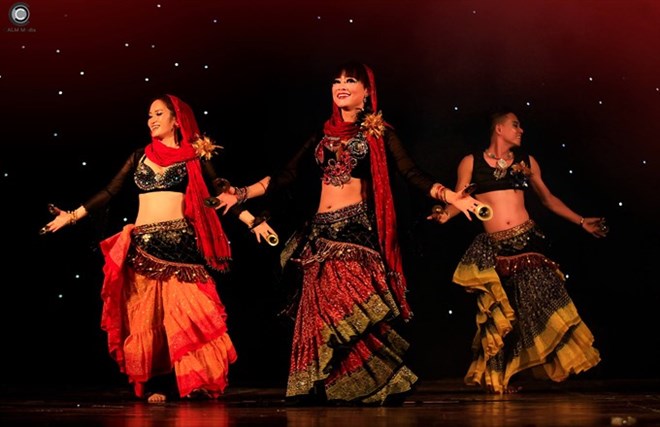
Performances by famous Vietnamese and international belly dancers are on show at the Ahlan International Belly Dance Festival held on October 19-23 in the northern province of Ninh Binh.

The Ahlan International Belly Dance Festival gathers many famous
Vietnamese and international artists. (Photo: VNA)
The event is a great chance for lovers of belly dancing to share their
experiences through workshops and enjoy performances by a number of well-known
belly dancers, including Aleksei Riaboshapka from Ukraine, Nari Heo from the
Republic of Korea, Nana Nazakawa from Japan, Gulden Fatkulla from Kazakhstan
and Summer Deng from China.
They are regarded as belly dance masters, capable of spreading knowledge about
their performance skills and inspiring their trainees.
Riaboshapka is a well-known performer and a recognised choreographer of belly
dance and oriental folkloric styles. Belly dance communities and festivals of
almost thirty countries welcomed his art and passion for oriental dance. He is
a leading teacher and judge of the League of Belly Dance Masters in Russia. In
his home country, he created his own unique dance company RA-Studio whose
students are taught by professionals. Many of them are winners of prestigious
contests worldwide. Alekei’s workshops are known to be interesting, creative
and fun. His talent, choreographic originality and bright personality have touched
many dancers.
"I am very happy to share my skills and soul to help dancers and see the belly
dance community grow,” he said.
"This is the second time we have organised an international belly dance
festival,” said dancer Ha Van, head of the organising board.
"We have tried to bring world masters to introduce them to Vietnamese belly
dancing as well as create the chance for domestic artists to exchange and find
inspiration.”
Source: VNA
The clothing of women reflects the culture of the Muong, Thai, Tay, Dao, and Mong ethnic groups in the northern province of Hoa Binh.
Gongs hold a special place in the cultural and spiritual life of the Muong ethnic people in Hoa Binh province. More than musical instruments, they are an indispensable part of community rituals and collective memory, echoing through generations as a spiritual thread linking the past, present, and future.
Preserving and promoting the cultural values of the Muong ethnic group has become an urgent task in the current context, as many traditional values face the risk of fading away. This effort requires not only protecting the cultural identity but also eliminating outdated customs and developing a modern cultural lifestyle, contributing to sustainable values for the Muong community in Hoa Binh province.
The Muong ethnic culture, deeply rooted in Vietnam’s mountainous north, continues to be preserved and revitalised by dedicated individuals and communities determined to safeguard their ancestral identity.
The Muong group is one of the largest ethnic minorities in Vietnam, primarily found in Hoa Binh province. The Muong people in Hoa Binh boast a rich and diverse cultural treasure that reflects the unique identity of this ethnic group. Accounting for over 63% of the province's population, they have created and preserved numerous distinctive cultural values, contributing to their unique identity. Their cultural heritage is an invaluable asset, at the heart of their national identity, and represents a vibrant spiritual life that must be preserved and promoted in today’s modern world.
For generations, the ethnic communities of Hoa Binh province, particularly the Muong people, have preserved vibrant festivals deeply intertwined with the region’s geography, nature, and social traditions. These celebrations enrich Hoa Binh’s spiritual life and cultural identity, reflecting both folk beliefs and the intermingling of ethnic customs. Many of these festivals have endured the test of time, passed down through generations and continuing to thrive today. Among them, the Khai Ha (Going Down to the Field) festival stands out as one of the most significant events of the Muong ethnic group.



